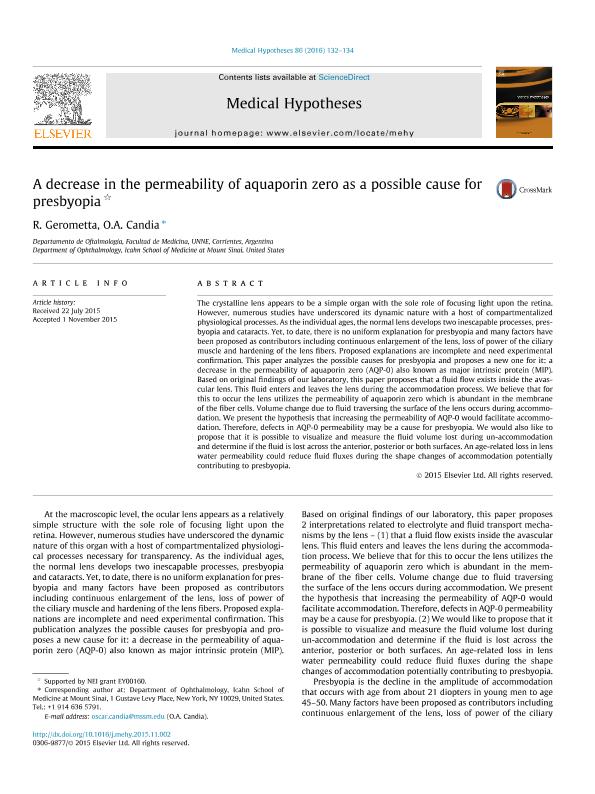Mostrar el registro sencillo del ítem
dc.contributor.author
Gerometta, Rosana María del Rosario

dc.contributor.author
Candia, O.A.
dc.date.available
2018-03-19T17:04:29Z
dc.date.issued
2016-01
dc.identifier.citation
Gerometta, Rosana María del Rosario; Candia, O.A.; A decrease in the permeability of aquaporin zero as a possible cause for presbyopia; Churchill Livingstone; Medical Hypotheses; 86; 1-2016; 132-134
dc.identifier.issn
0306-9877
dc.identifier.uri
http://hdl.handle.net/11336/39213
dc.description.abstract
The crystalline lens appears to be a simple organ with the sole role of focusing light upon the retina. However, numerous studies have underscored its dynamic nature with a host of compartmentalized physiological processes. As the individual ages, the normal lens develops two inescapable processes, presbyopia and cataracts. Yet, to date, there is no uniform explanation for presbyopia and many factors have been proposed as contributors including continuous enlargement of the lens, loss of power of the ciliary muscle and hardening of the lens fibers. Proposed explanations are incomplete and need experimental confirmation. This paper analyzes the possible causes for presbyopia and proposes a new one for it: a decrease in the permeability of aquaporin zero (AQP-0) also known as major intrinsic protein (MIP). Based on original findings of our laboratory, this paper proposes that a fluid flow exists inside the avascular lens. This fluid enters and leaves the lens during the accommodation process. We believe that for this to occur the lens utilizes the permeability of aquaporin zero which is abundant in the membrane of the fiber cells. Volume change due to fluid traversing the surface of the lens occurs during accommodation. We present the hypothesis that increasing the permeability of AQP-0 would facilitate accommodation. Therefore, defects in AQP-0 permeability may be a cause for presbyopia. We would also like to propose that it is possible to visualize and measure the fluid volume lost during un-accommodation and determine if the fluid is lost across the anterior, posterior or both surfaces. An age-related loss in lens water permeability could reduce fluid fluxes during the shape changes of accommodation potentially contributing to presbyopia.
dc.format
application/pdf
dc.language.iso
eng
dc.publisher
Churchill Livingstone

dc.rights
info:eu-repo/semantics/openAccess
dc.rights.uri
https://creativecommons.org/licenses/by-nc-sa/2.5/ar/
dc.subject
Lens
dc.subject
Cataracts
dc.subject
Presbyopia
dc.subject
Aquaporin
dc.subject.classification
Medicina Critica y de Emergencia

dc.subject.classification
Medicina Clínica

dc.subject.classification
CIENCIAS MÉDICAS Y DE LA SALUD

dc.title
A decrease in the permeability of aquaporin zero as a possible cause for presbyopia
dc.type
info:eu-repo/semantics/article
dc.type
info:ar-repo/semantics/artículo
dc.type
info:eu-repo/semantics/publishedVersion
dc.date.updated
2018-03-09T18:46:22Z
dc.identifier.eissn
1532-2777
dc.journal.volume
86
dc.journal.pagination
132-134
dc.journal.pais
Estados Unidos

dc.journal.ciudad
New York
dc.description.fil
Fil: Gerometta, Rosana María del Rosario. Universidad Nacional del Nordeste; Argentina. Consejo Nacional de Investigaciones Científicas y Técnicas. Centro Científico Tecnológico Conicet - Nordeste; Argentina
dc.description.fil
Fil: Candia, O.A.. Icahn School of Medicine at Mount Sinai; Estados Unidos
dc.journal.title
Medical Hypotheses

dc.relation.alternativeid
info:eu-repo/semantics/altIdentifier/doi/http://dx.doi.org/10.1016/j.mehy.2015.11.002
dc.relation.alternativeid
info:eu-repo/semantics/altIdentifier/url/https://www.sciencedirect.com/science/article/pii/S0306987715004144
Archivos asociados
